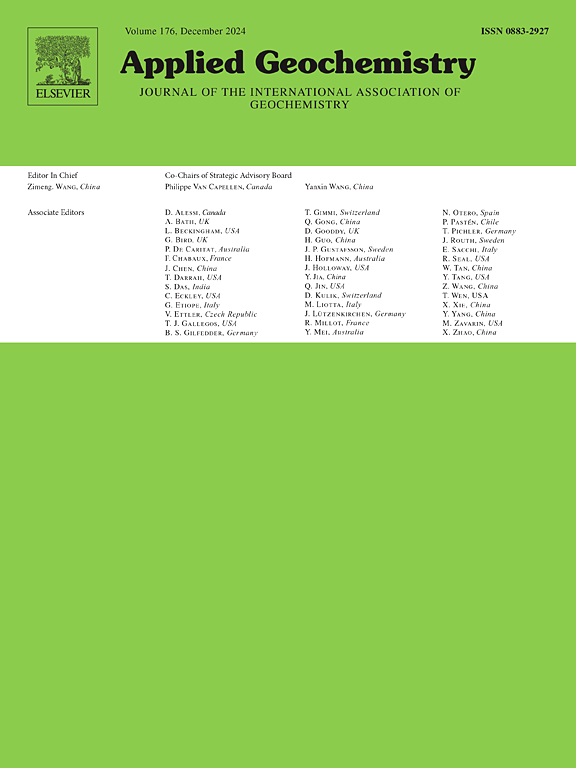Nitrogen distribution and nitrogen isotope fractionation in synthetic 2:1 phyllosilicates under hydrothermal conditions at 200 °C and saturated vapor pressure
IF 3.1
3区 地球科学
Q1 GEOCHEMISTRY & GEOPHYSICS
引用次数: 0
Abstract
This study investigates nitrogen distribution and isotope fractionation within synthetic 2:1 phyllosilicates, simulating submarine hydrothermal environments at 200 °C and saturated vapor pressure. XRD and EDS results revealed the potential coexistence of multiple cations in the interlayer of synthetic 2:1 phyllosilicate, concurrently suggesting cation substitution in the tetrahedral and/or octahedral sheets. Meanwhile, the iron-enriched 25-5 sample exhibited restricted interlayer expansibility. NH4+ absorptions were identified in the NH4-stretching (3200–2800 cm−1) and NH4-bending (1450–1400 cm−1) regions, with wavenumber shifts indicating the influence of interlayer water removal. At pH 10.56, over 95% of nitrogen was released into the gas phase, while at pH 8.88, nitrogen proportions in the liquid and gas phases were comparable (average 48–49%). Experiments with iron at pH ∼8.80 showed that the nitrogen proportion in the gas phase (average 28%) was more than twofold lower than that in the liquid phase (average 68%). Equilibrium isotope fractionation factors indicated discernible preference for heavier nitrogen isotopes in the solid phase (αsolid-liquid = 1.009–1.021 and αsolid-gas = 1.011–1.027). The αliquid-gas range for sample 25–2 was 1.001–1.008, while that for the iron-enriched composite 25–5 was 0.997–1.010. Our experimental studies have confirmed that, in the absence of exchange interactions with external substances possessing different nitrogen isotope ratios, nitrogen isotope fractionation between ammonium and ammonia, controlled by variations in temperature and pH during mineralization, plays a crucial role in the variation of nitrogen isotope ratios. Additionally, we confirmed that metal-amines influence nitrogen isotope fractionation by modulating ammonia gas emission. These findings enhance our understanding of nitrogen cycling across the gas, liquid, and solid phases in submarine hydrothermal systems.
200℃、饱和蒸汽压水热条件下合成2:1层状硅酸盐中氮的分布及氮同位素分馏
研究了合成2:1层状硅酸盐中氮的分布和同位素分馏,模拟了200℃、饱和蒸汽压下的海底热液环境。XRD和EDS结果显示,合成的2:1层状硅酸盐夹层中可能存在多种阳离子共存,同时表明阳离子在四面体和/或八面体薄片中取代。富铁25-5样品的层间膨胀性受限制。在NH4-拉伸(3200-2800 cm−1)和NH4-弯曲(1450-1400 cm−1)区域发现了NH4+吸收,波数移位表明层间水去除的影响。在pH为10.56时,95%以上的氮被释放到气相中,而在pH为8.88时,液相和气相中氮的比例相当(平均为48-49%)。在pH ~ 8.80条件下对铁进行的实验表明,气相中氮的比例(平均28%)比液相中的氮的比例(平均68%)低两倍以上。平衡同位素分馏因子表明,固相(α固液= 1.009-1.021,α固气= 1.011-1.027)中较重的氮同位素具有明显的优势。样品25-2 α液气范围为1.001 ~ 1.008,富铁复合物25-5 α液气范围为0.997 ~ 1.010。我们的实验研究证实,在不与具有不同氮同位素比值的外部物质进行交换作用的情况下,矿化过程中受温度和pH变化控制的铵和氨之间的氮同位素分馏对氮同位素比值的变化起着至关重要的作用。此外,我们证实了金属胺通过调节氨气排放影响氮同位素分馏。这些发现增强了我们对海底热液系统中气态、液态和固相氮循环的理解。
本文章由计算机程序翻译,如有差异,请以英文原文为准。
求助全文
约1分钟内获得全文
求助全文
来源期刊

Applied Geochemistry
地学-地球化学与地球物理
CiteScore
6.10
自引率
8.80%
发文量
272
审稿时长
65 days
期刊介绍:
Applied Geochemistry is an international journal devoted to publication of original research papers, rapid research communications and selected review papers in geochemistry and urban geochemistry which have some practical application to an aspect of human endeavour, such as the preservation of the environment, health, waste disposal and the search for resources. Papers on applications of inorganic, organic and isotope geochemistry and geochemical processes are therefore welcome provided they meet the main criterion. Spatial and temporal monitoring case studies are only of interest to our international readership if they present new ideas of broad application.
Topics covered include: (1) Environmental geochemistry (including natural and anthropogenic aspects, and protection and remediation strategies); (2) Hydrogeochemistry (surface and groundwater); (3) Medical (urban) geochemistry; (4) The search for energy resources (in particular unconventional oil and gas or emerging metal resources); (5) Energy exploitation (in particular geothermal energy and CCS); (6) Upgrading of energy and mineral resources where there is a direct geochemical application; and (7) Waste disposal, including nuclear waste disposal.
 求助内容:
求助内容: 应助结果提醒方式:
应助结果提醒方式:


